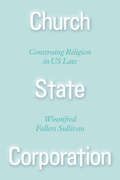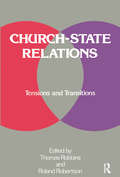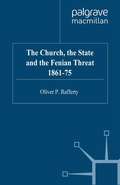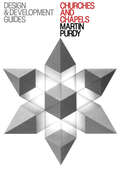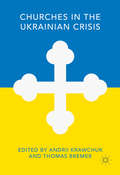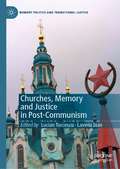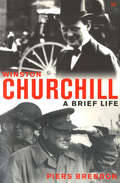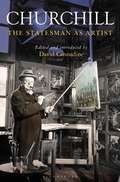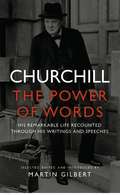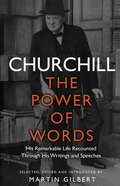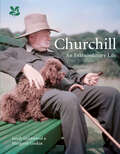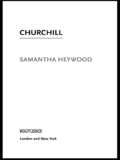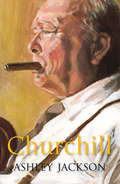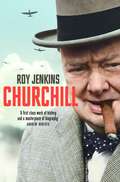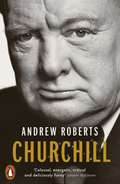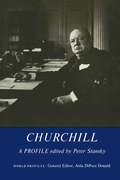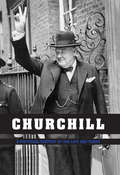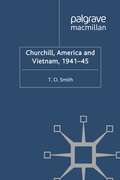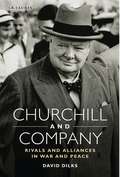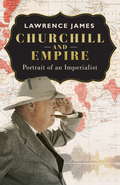- Table View
- List View
Church State Corporation: Construing Religion in US Law
by Winnifred Fallers SullivanChurch and state: a simple phrase that reflects one of the most famous and fraught relationships in the history of the United States. But what exactly is “the church,” and how is it understood in US law today? In Church State Corporation, religion and law scholar Winnifred Fallers Sullivan uncovers the deeply ambiguous and often unacknowledged ways in which Christian theology remains alive and at work in the American legal imagination. Through readings of the opinions of the US Supreme Court and other legal texts, Sullivan shows how “the church” as a religious collective is granted special privilege in US law. In-depth analyses of Hosanna-Tabor v. EEOC and Burwell v. Hobby Lobby reveal that the law tends to honor the religious rights of the group—whether in the form of a church, as in Hosanna-Tabor, or in corporate form, as in Hobby Lobby—over the rights of the individual, offering corporate religious entities an autonomy denied to their respective members. In discussing the various communities that construct the “church-shaped space” in American law, Sullivan also delves into disputes over church property, the legal exploitation of the black church in the criminal justice system, and the recent case of Masterpiece Cakeshop v. Colorado Civil Rights Commission. Brimming with insight, Church State Corporation provocatively challenges our most basic beliefs about the ties between religion and law in ostensibly secular democracies.
Church State Corporation: Construing Religion in US Law
by Winnifred Fallers SullivanChurch and state: a simple phrase that reflects one of the most famous and fraught relationships in the history of the United States. But what exactly is “the church,” and how is it understood in US law today? In Church State Corporation, religion and law scholar Winnifred Fallers Sullivan uncovers the deeply ambiguous and often unacknowledged ways in which Christian theology remains alive and at work in the American legal imagination. Through readings of the opinions of the US Supreme Court and other legal texts, Sullivan shows how “the church” as a religious collective is granted special privilege in US law. In-depth analyses of Hosanna-Tabor v. EEOC and Burwell v. Hobby Lobby reveal that the law tends to honor the religious rights of the group—whether in the form of a church, as in Hosanna-Tabor, or in corporate form, as in Hobby Lobby—over the rights of the individual, offering corporate religious entities an autonomy denied to their respective members. In discussing the various communities that construct the “church-shaped space” in American law, Sullivan also delves into disputes over church property, the legal exploitation of the black church in the criminal justice system, and the recent case of Masterpiece Cakeshop v. Colorado Civil Rights Commission. Brimming with insight, Church State Corporation provocatively challenges our most basic beliefs about the ties between religion and law in ostensibly secular democracies.
Church State Corporation: Construing Religion in US Law
by Winnifred Fallers SullivanChurch and state: a simple phrase that reflects one of the most famous and fraught relationships in the history of the United States. But what exactly is “the church,” and how is it understood in US law today? In Church State Corporation, religion and law scholar Winnifred Fallers Sullivan uncovers the deeply ambiguous and often unacknowledged ways in which Christian theology remains alive and at work in the American legal imagination. Through readings of the opinions of the US Supreme Court and other legal texts, Sullivan shows how “the church” as a religious collective is granted special privilege in US law. In-depth analyses of Hosanna-Tabor v. EEOC and Burwell v. Hobby Lobby reveal that the law tends to honor the religious rights of the group—whether in the form of a church, as in Hosanna-Tabor, or in corporate form, as in Hobby Lobby—over the rights of the individual, offering corporate religious entities an autonomy denied to their respective members. In discussing the various communities that construct the “church-shaped space” in American law, Sullivan also delves into disputes over church property, the legal exploitation of the black church in the criminal justice system, and the recent case of Masterpiece Cakeshop v. Colorado Civil Rights Commission. Brimming with insight, Church State Corporation provocatively challenges our most basic beliefs about the ties between religion and law in ostensibly secular democracies.
Church-state Relations: Tensions and Transitions
by Thomas RobbinsEncounters between agents of the state and religious organizations have been increasing throughout the world, thus the need to understand the relationships between religion and other major domains of life is increasingly important. In this comprehensive reader on church-state relations, scholars examine the connections between religion and political life from a comparative perspective.
Church-state Relations: Tensions and Transitions
by THOMAS ROBBINS; ROLAND ROBERTSONEncounters between agents of the state and religious organizations have been increasing throughout the world, thus the need to understand the relationships between religion and other major domains of life is increasingly important. In this comprehensive reader on church-state relations, scholars examine the connections between religion and political life from a comparative perspective.
The Church, the State and the Fenian Threat 1861–75
by O. RaffertyThis book examines the mechanisms of the Irish revolutionary Fenian Brotherhood in the early years of its existence. Drawing on a wide range of material from places as diverse as Rome and Toronto it seeks to set the Fenian struggle within the context of competing church and state influence in mid-nineteenth century Irish society. It is particularly strong on the transatlantic comparative dimensions of church, state and Fenian activity, and demonstrates how the Fenians managed to change, forever, the terms of Irish political and social debate.
Churches and Chapels: A Design and Development Guide
by Martin PurdyChurches and Chapels: A Design and Development Guide is a reference for structure approach to design, development, or alteration of a building. The book deals with designing or altering traditional Western congregational halls and places of worship through a harmonious rending of religious worship and social action. Part I of the book focuses on background, presenting general ideas and influences that made today's churches. Questions such as adapt or replace and concerns about design are addressed. This part also examines the role of today's clients and the possible types of churches and chapels that will prove desirable and satisfactory. Part II discusses the design process covering the need for a feasibility study and agreed design development. The feasibility study addresses retention of parts of the structure, size of the structure, costs, and consideration of other building designs. Design analysis involves evaluation of the architectural considerations that include Western congregational halls, design ideas, check-ups, and sketching. The details of the scheme design contain precise information that will serve as basis for the client to modify or accept and for the authorities to approve. Throughout this book, case studies that are relevant for each topic are also given. This guide is useful for administration of local, parochial, and district congregations. This book can likewise be appreciated by architects and structural engineers.
Churches in the Ukrainian Crisis
by Andrii Krawchuk and Thomas BremerThis volume explores the churches of Ukraine and their involvement in the recent movement for social justice and dignity within the country. In November of 2013, citizens of Ukraine gathered on Kyiv's central square (Maidan) to protest against a government that had reneged on its promise to sign a trade agreement with Europe. The Euromaidan protest included members of various Christian churches in Ukraine, who stood together and demanded government accountability and closer ties with Europe. In response, state forces massacred over one hundred unarmed civilians. The atrocity precipitated a rapid sequence of events: the president fled the country, a provisional government was put in place, and Russia annexed Crimea and intervened militarily in eastern Ukraine. An examination of Ukrainian churches’ involvement in this protest and the fall-out that it inspired opens up other questions and discussions about the churches’ identity and role in the country’s culture and its social and political history. Volume contributors examine Ukrainian churches’ historical development and singularity; their quest for autonomy; their active involvement in identity formation; their interpretations of the war and its causes; and the paths they have charted toward peace and unity.
Churches, Memory and Justice in Post-Communism (Memory Politics and Transitional Justice)
by Lucian Turcescu Lavinia StanThis book is the first to systematically examine the connection between religion and transitional justice in post-communism. There are four main goals motivating this book: 1) to explain how civil society (groups such as religious denominations) contribute to transitional justice efforts to address and redress past dictatorial repression; 2) to ascertain the impact of state-led reckoning programs on religious communities and their members; 3) to renew the focus on the factors that determine the adoption (or rejection) of efforts to reckon with past human rights abuses in post-communism; and 4) to examine the limitations of enacting specific transitional justice methods, programs and practices in post-communist Central and Eastern Europe and the Former Soviet Union countries, whose democratization has differed in terms of its nature and pace. Various churches and their relationship with the communist states are covered in the following countries: Germany, Poland, the Czech Republic, Slovakia, Romania, Albania, Bulgaria, Estonia, Latvia, Lithuania, Russia and Belarus.
Churchill: A Brief Life (Biografias-memorias Ser.)
by Dr Piers BrendonThis astute biography brilliantly captures, in one volume, the full range of Winston Churchill's astonishing career. perhaps the greatest political figure of modern times, Churchill's achievement extended well beyond his emblematic role in the Second World War. Piers Brendon brings great wit and dozens of pungent anecdotes to this penetrating account, illuminating the 'monstrous compound' of courage and egotism, rudeness and humour, brutality and compassion that was Winston Churchill. What emerges from these pages is one of the most fascinating and colourful figures of the twentieth century. To rescue Churchill from being buried under millions of words Piers Brendon has written a brief but brilliant profile of the colossus.
Churchill: The Statesman as Artist
by David CannadineAcross almost 50 years, Winston Churchill produced more than 500 paintings. His subjects included his family homes at Blenheim and Chartwell, evocative coastal scenes on the French Riviera, and many sun-drenched depictions of Marrakesh in Morocco, as well as still life pictures and an extraordinarily revealing self-portrait, painted during a particularly troubled time in his life. In war and peace, Churchill came to enjoy painting as his primary means of relaxation from the strain of public affairs. In his introduction to Churchill: The Statesman as Artist, David Cannadine provides the most important account yet of Churchill's life in art, which was not just a private hobby, but also, from 1945 onwards, an essential element of his public fame. The first part of this book brings together for the first time all of Churchill's writings and speeches on art, not only 'Painting as a Pastime', but his addresses to the Royal Academy, his reviews of two of the Academy's summer exhibitions, and an important speech he delivered about art and freedom in 1937. The second part of the book provides previously uncollected critical accounts of his work by some of Churchill's contemporaries: Augustus John's hitherto unpublished introduction to the Royal Academy exhibition of Churchill's paintings in 1959, and essays and reviews by Churchill's acquaintances Sir John Rothenstein, Professor Thomas Bodkin and the art critic Eric Newton. The book is lavishly illustrated with reproductions of many of Churchill's paintings, some of them appearing for the first time. Here is Churchill the artist more fully revealed than ever before.
Churchill: The Power of Words
by Winston ChurchillA collection of the best and most quoted speeches and writings of Nobel Prize-winner Winston Churchill Winston Churchill knew the power of words. In speeches, books, and articles, he expressed his feelings and laid out his vision for the future. His wartime writings and speeches have fascinated generation after generation with their powerful narrative style and thoughtful reflection.Martin Gilbert, Churchill's official biographer, has chosen passages that express the essence of Churchill's thoughts and describe-in his own inimitable words-the main adventures of his life and the main crises of his career. From first to last, they give insight into his life, how it evolved, and how he made his mark on the British and world stage.
Churchill: The Power Of Words
by Winston S. Churchill Dr Martin GilbertWinston Churchill understood and wielded the power of words throughout his six decades in the public eye. His wartime writings and speeches revealed both his vision for the future and his own personal feelings, fascinating generation after generation with their powerful style and thoughtful reflection. In this book Churchill’s official biographer, Martin Gilbert, has skilfully selected 200 extracts from his entire oeuvre of books, articles and speeches that reflect his life story, career and philosophy. From intimate memories of his childhood to his contributions to half a century of debates on war and social policy, we see how Churchill used words for different purposes: to argue for moral causes; to advocate action in the national and international spheres, and to tell of his own struggles, setbacks and achievements. Martin Gilbert’s informed choice of extracts and his illuminating explanations linking them together create a compelling biography of Churchill as recounted in the great man’s own inimitable words.
Churchill: An Extraordinary Life
by Sarah Gristwood Margaret Gaskin National Trust BooksA short illustrated life of one of Britain's most revered people of all time, covering all periods of his life but always returning to his literal and spiritual home, Chartwell.
Churchill
by Samantha HeywoodChurchill examines the influential career of Winston Churchill, British Prime Minster during the Second World War and from 1951–55. It discusses his early career as Secretary of State for War and Air and Chancellor of the Exchequer, Churchill as Warlord, and Churchill in opposition and the 1951 government. The book examines a wide variety of sources from contemporary newspaper accounts to Churchill's letters to his wife.
Churchill
by Samantha HeywoodChurchill examines the influential career of Winston Churchill, British Prime Minster during the Second World War and from 1951–55. It discusses his early career as Secretary of State for War and Air and Chancellor of the Exchequer, Churchill as Warlord, and Churchill in opposition and the 1951 government. The book examines a wide variety of sources from contemporary newspaper accounts to Churchill's letters to his wife.
Churchill
by Ashley JacksonUniquely endowed with talent, energy and determination, Winston Churchill was, as a close wartime colleague put it, 'unlike anyone you have ever met before'.To many, he was the saviour of the nation, even of Western civilization, 'the greatest Briton' who ever lived. Others would have agreed with Evelyn Waugh who described him 'always in the wrong, surrounded by crooks, a terrible father, a radio personality'. Whatever one's view, Winston Churchill remains splendidly unreduced and enormous fun.Ashley Jackson describes the contours and contradictions of Churchill's remarkable life and career as a soldier, politician, historian, journalist, painter and homemaker. In doing so, he resists the temptation to conflate Churchill's post-war career with Britain's demise on the international stage. Nor does he endorse the notion that Churchill became an anachronism as he lived and continued to work, at a prodigious rate, through his seventies and eighties. From thrusting subaltern to high-flying politician, Cabinet outcast to elder statesman, this is the eternally fascinating story of Winston Churchill's appointment with destiny.
Churchill: A Biography (Atalaya Ser. #Vol. 111)
by Roy JenkinsFrom the admiralty to the miner's strike, from the Battle of Britain to eventual victory over Nazi Germany, Churchill oversaw some of the most important events the world has ever seen. Winning the Nobel Prize in Literature for his personal writing and cautioning against a powerful Soviet Russia in his later years in office, his larger-than-life and complex personality has continued to fascinate writers and historians.In this comprehensive biography, Roy Jenkins faithfully presents these events, while also managing to convey the contradictions and quirks in Churchill's character. Weaving together in-depth analysis and brilliant historical research, Jenkins has succeeded in crafting this magnificent one-volume account packed with insights that only a fellow politician can convey. Bringing to life the statesman, writer, speaker and leader, Churchill is packed with insights into one of the most important figures of the twentieth century.
Churchill: The Statesman as Artist
by Professor Sir David CannadineAcross almost 50 years, Winston Churchill produced more than 500 paintings. His subjects included his family homes at Blenheim and Chartwell, evocative coastal scenes on the French Riviera, and many sun-drenched depictions of Marrakesh in Morocco, as well as still life pictures and an extraordinarily revealing self-portrait, painted during a particularly troubled time in his life. In war and peace, Churchill came to enjoy painting as his primary means of relaxation from the strain of public affairs. In his introduction to Churchill: The Statesman as Artist, David Cannadine provides the most important account yet of Churchill's life in art, which was not just a private hobby, but also, from 1945 onwards, an essential element of his public fame. The first part of this book brings together for the first time all of Churchill's writings and speeches on art, not only 'Painting as a Pastime', but his addresses to the Royal Academy, his reviews of two of the Academy's summer exhibitions, and an important speech he delivered about art and freedom in 1937. The second part of the book provides previously uncollected critical accounts of his work by some of Churchill's contemporaries: Augustus John's hitherto unpublished introduction to the Royal Academy exhibition of Churchill's paintings in 1959, and essays and reviews by Churchill's acquaintances Sir John Rothenstein, Professor Thomas Bodkin and the art critic Eric Newton. The book is lavishly illustrated with reproductions of many of Churchill's paintings, some of them appearing for the first time. Here is Churchill the artist more fully revealed than ever before.
Churchill: Walking with Destiny (Phoenix Giants Ser.)
by Andrew Roberts'Undoubtedly the best single-volume life of Churchill ever written' Dominic Sandbrook, Sunday TimesA magnificently fresh and unexpected biography of Churchill, by one of Britain's most acclaimed historiansWinston Churchill towers over every other figure in twentieth-century British history. By the time of his death at the age of 90 in 1965, many thought him to be the greatest man in the world.There have been over a thousand previous biographies of Churchill. Andrew Roberts now draws on over forty new sources, including the private diaries of King George VI, used in no previous Churchill biography to depict him more intimately and persuasively than any of its predecessors. The book in no way conceals Churchill's faults and it allows the reader to appreciate his virtues and character in full: his titanic capacity for work (and drink), his ability see the big picture, his willingness to take risks and insistence on being where the action was, his good humour even in the most desperate circumstances, the breadth and strength of his friendships and his extraordinary propensity to burst into tears at unexpected moments. Above all, it shows us the wellsprings of his personality - his lifelong desire to please his father (even long after his father's death) but aristocratic disdain for the opinions of almost everyone else, his love of the British Empire, his sense of history and its connection to the present.During the Second World War, Churchill summoned a particular scientist to see him several times for technical advice. 'It was the same whenever we met', wrote the young man, 'I had a feeling of being recharged by a source of living power.' Harry Hopkins, President Roosevelt's emissary, wrote 'Wherever he was, there was a battlefront.' Field Marshal Sir Alan Brooke, Churchill's essential partner in strategy and most severe critic in private, wrote in his diary, 'I thank God I was given such an opportunity of working alongside such a man, and of having my eyes opened to the fact that occasionally supermen exist on this earth.'
Churchill: A Pictorial History Of His Life And Times (British History In Perspective Ser.)
by Ian S. WoodSir Winston Churchill, voted the greatest Briton of all time, died 50 years ago on January 24th 1965. Born on November 30th 1874, he entered Parliament in 1900 and dominated political life for over half a century until his retirement in 1955. His leadership of the British people in the Second World War (when he was Prime Minister from 1940 to 1945) was in inspiration to them and the free world and remains a period of defining historical importance. His career would have been a significant one even had he not become Prime Minister in 1940 (as he also won the Nobel Prize for Literature) and he went on to play a major political role for another ten years after 1945 serving again as the country's premier from 1951 to 1955. Noted Churchill historian Ian S. Wood assesses his character and achievements in this 50th anniversary edition which offers a remarkable visual record of Churchill's life and times
Churchill, America and Vietnam, 1941-45
by T. SmithPut in the wider context of British imperial and diplomatic aims in 1941-1945, the book clarifies the importance of Vietnam to Britain's regional objectives in Southeast Asia; concluding that Churchill was willing to sacrifice French colonial interests in Vietnam for his all-important 'special relationship' with the United States.
Churchill and Company: Allies and Rivals in War and Peace
by David DilksWinston Churchill, the great wartime leader and peacetime Prime Minister, is one of the dominating figures of the 20th century. In this stimulating and original book, David Dilks - the eminent historian of modern Britain and a leading Churchill scholar - provides a fascinating source of new discoveries and insights. He shows Churchill, not only as a war leader and international statesman, but also as a private person - with a rich variety of interests, enthusiasms, friendships and rivalries. Churchill's relations with other leading politicians and statesmen of the age - both within Britain and internationally - illuminate his handling of friends and enemies. Sometimes these categories were not easily separated; for a long while, Churchill thought of Stalin as a friend or at least a comrade in arms, and only with extreme reluctance did he come to look upon him ultimately as an enemy. He regarded Roosevelt with admiration and gratitude, yet the balance of evidence suggests that the President felt less warmly towards him, especially after 1943. Dilks casts new and penetrating light on Churchill during World War II, including his dramatic and troubled relationship with Charles de Gaulle - where political problems were softened by Churchill's love of France. The aftermath of World War II, relations with Stalin, the Soviet Union and the Cold War all dominated Churchill's subsequent career. The last chapter draws attention to the influence of 'history' on statesmen and others, not least because no public man of the last century - with the possible exception of de Gaulle - has influenced on Churchill's scale, or with his effectiveness, the writing and the making of history. Whether in or out of office, Churchill's influence has been felt in all areas of British politics and national life. David Dilks brings Churchill to life for all those interested modern British and international history whether student, specialist or general reader.
Churchill and Empire: A Portrait Of An Imperialist
by Lawrence JamesA genuinely new biography of Churchill, focusing on his contradictory and lifelong relationship with the British Empire.One of our finest narrative historians, and journalist for the SUNDAY TIMES and LITERARY REVIEW, Lawrence James, has written a genuinely new biography of Winston Churchill, set within a fully detailed historical context, but solely focusing on his relationship with the British Empire. As a young army officer in the late 19th century, Churchill's first experience of the Empire was serving in conflicts in India, South Africa and the Sudan. His attitude towards the Empire at the time was the stereotypical Victorian paternalistic approach - a combination of feeling responsible and feeling superior. Conscious even then of his political career ahead, Churchill's natural benevolence towards the Empire was occasionally overruled for political reasons, and he found himself reluctantly supporting - or at least not publicly condemning - British atrocities.As a politician he consistently relied on the Empire for support during crises, but was angered by any demands for nationalisation. He held what many would regard today as racist views, in that he felt that some nationalities were superior to others, but he didn't regard those positions as fixed. His (some might say obsequious) relationship with America reflected that view. America was a former colony where the natives had become worthy to rule themselves, but - he felt - still had that tie to Britain. Thus he overlooked the frequently expressed American view that the Empire was a hangover from a bygone era of colonisation, and reflected poorly on Britain's ability to conduct herself as a political power in the current world order.This outmoded attitude was one of the reasons the British voters rejected him after a Second World War in which - it was universally felt - he had led the country brilliantly. His attitude remained Victorian in a world that was shaping up very differently. However, it would be a mistake to consider Churchill merely as an anachronistic soldier. He grasped the problems of the Cold War immediately, believing that immature nations prematurely given independence would be more likely to be sucked into the vortex of Communism. This view chimed with American foreign policy, and made the Americans rather more pragmatic about their demands for self-governance for Empire countries.Lawrence James has written a fascinating portrait of an endlessly interesting statesman - and one that includes tantalising vignettes about his penchants for silk underwear and champagne.
